Multiple Choice
Identify the
choice that best completes the statement or answers the question.
|
|
|
1.
|
In the diagram below, the circuit has one battery and two identical light
bulbs. (MCAS 2008)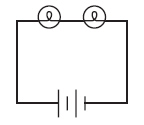 If one
light bulb is removed, which of the following could replace it so that the remaining light bulb is
dimmer?
|
|
|
2.
|
Which of the following ammeters is shown with an incorrect reading? (MCAS 2008)
|
|
|
3.
|
The diagram below shows an electrical
circuit. (MCAS 2007)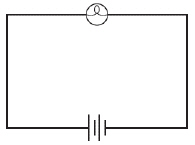 Which of
the following best explains why energy stored in the battery power source diminishes over time
when this circuit is complete? a. | Energy is destroyed when the light bulb operates. | b. | The light bulb
transforms energy into light and heat. | c. | The light bulb converts the negative charge of
electrons into light and heat. | d. | The power source generates energy more slowly
than the light bulb consumes it. |
|
|
|
4.
|
Mr. Jenkins constructed a circuit consisting of a variable source, wires, and a
resistor. In order to triple the amount of current, how should he change the voltage of the source?
(MCAS 2006)
a. | make the voltage three times larger | c. | make the voltage nine times
larger | b. | make the voltage one-third as great | d. | make the voltage one-ninth as
great |
|
|
|
5.
|
A simple circuit is shown in the diagram below. (MCAS 2009) In which of the
following circuits will bulb X have the same brightness as in the circuit above, if all batteries and
all light bulbs are identical?
|
|
|
6.
|
Large amounts of current can damage a circuit. Which of the following changes in
a series circuit will result in an increase in current? (MCAS
2009)
a. | The voltage is halved and the resistance is halved. | b. | The voltage is
halved and the resistance is doubled. | c. | The voltage is doubled and the resistance is
halved. | d. | The voltage is doubled and the resistance is doubled. |
|
|
|
7.
|
Based on Ohm’s law, which of the following statements explains what must
happen when the voltage across a resistor is decreased? (MCAS
2009)
a. | The resistance of the resistor increases. | b. | The resistance of
the resistor decreases. | c. | The current through the resistor
increases. | d. | The current through the resistor decreases. |
|
|
|
8.
|
A circuit diagram is shown below. (MCAS
2009) Which component in the diagram converts
chemical energy into electrical energy? a. | component W | b. | component X | c. | component Y | d. | component
Z |
|
|
|
9.
|
Which of the following actions would increase the current through a circuit
component? (MCAS 2010)
a. | decreasing the power in the component | b. | increasing the resistance of the
component | c. | increasing the voltage across the component | d. | placing another
identical component in series in the circuit |
|
|
|
10.
|
The diagram below shows a simple circuit.
(MCAS 2011)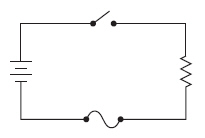 Which component is the
source of energy in this circuit?
|
|
|
11.
|
The measurements in the table below are from four circuits that each have the
same components except for the battery. (MCAS 2011) Which of the following statements describes how voltage, current, and resistance
are related by Ohm’s law in these circuits? a. | As voltage increases, current decreases and resistance decreases. | b. | As voltage
increases, current increases and resistance stays the same. | c. | As voltage
increases, current decreases and resistance stays the same. | d. | As voltage
increases, current stays the same and resistance decreases. |
|
|
|
12.
|
The diagram below shows a simple electric circuit. (MCAS 2010)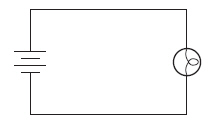 Which of the following
statements describes the function of the battery? a. | It reduces the flow of electrons. | b. | It transmits light through the
circuit. | c. | It pushes electrons through the circuit. | d. | It releases light
during a chemical reaction. |
|
|
|
13.
|
A battery is connected to a light bulb with copper wire to complete a circuit.
The bulb immediately lights. Which of the following best describes why the bulb lights? (MCAS 2012)
a. | The battery supplies electrons,which move through the bulb but not the
wire. | b. | The battery supplies chemicals, which pass through the bulb to the end of the
wire. | c. | The battery supplies heat energy, which causes the bulb to produce light
energy. | d. | The battery supplies voltage, which causes electrons throughout the circuit to
move. |
|
|
|
14.
|
The diagram below shows an electrical circuit with three bulbs and three
switches. The switches are labeled X, Y, and Z. When all three switches are closed, as shown, all
three bulbs are lit. (MCAS 2012)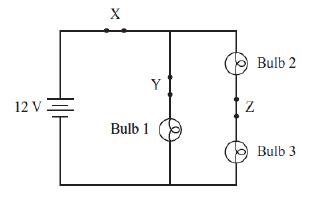 Which of
the following statements describes what will happen if switch Z is opened? a. | Only bulb 1 will be lit. | c. | All three bulbs will be
lit. | b. | Only bulb 3 will be lit. | d. | None of the bulbs will be lit. |
|
|
|
15.
|
A student has a circuit that is missing a component at location X, as
shown in the diagram below. (MCAS 2013)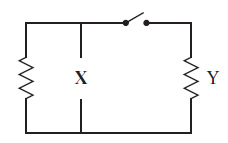 The student wants component Y to warm up after the switch is closed. Which of the
following components should the student add to the circuit at location X?
|
Problems
|
|
|
16.
|
The graph below relates the current to voltage data for a resistor. 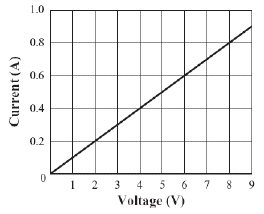 Which of the following is the value of the resistor? (Modified MCAS 2007)
|
|
|
17.
|
The two resistors shown below are connected to identical power sources. Resistor
1 has a resistance of 30 W, and resistor 2 has a resistance of 45 W. The current in resistor 1 is 2 A.  What is
the current in resistor 2? (Modified MCAS 2007)
|
|
|
18.
|
What is the voltage in a circuit with a current of 3 A and a total resistance of
12 W? (Modified MCAS 2006)
|
|
|
19.
|
What is the voltage across the terminals of a 23 W
resistor that has 0.065 A of current flowing through it? (Modified MCAS
2010)
|
|
|
20.
|
An electric circuit is shown below. The
accompanying table shows the current measured at different levels of resistance. 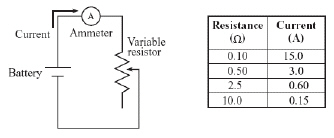 Based on the data shown in the table, what is the voltage drop across the
variable resistor? (Modified MCAS 2006)
|
|
|
21.
|
A microwave oven uses 10 A of current when connected to a wall outlet that
provides 120 V of electricity. What is the resistance of the microwave oven? (Modified MCAS 2010)
|
|
|
22.
|
The diagram below shows a simple circuit. 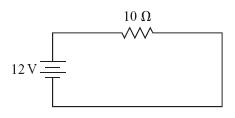 What is
the current in the circuit? (Modified MCAS 2011)
|
|
|
23.
|
A simple circuit has a current of 3.0 A and a resistance of 5.0 W. What is the voltage supplied by the battery of this circuit? (Modified MCAS 2012)
|
|
|
24.
|
An appliance draws 4 A of current when connected to 120 V. What is the
resistance of the appliance? (Modified MCAS 2013)
|
|
|
25.
|
A current of 2 A passes through an 8 W load. What is
the potential difference across the load? (Modified MCAS
2013)
|
|
|
26.
|
The graph below shows the relationship between current and voltage in a circuit.
Resistance in the circuit remains constant. 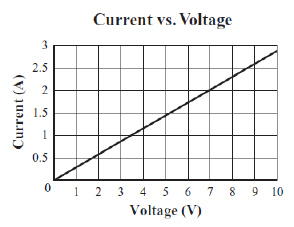 What is the resistance
of this circuit? (Modified MCAS 2012)
|
Open-Response
|
|
|
27.
|
A circuit with three identical light bulbs is shown in the diagram below. (MCAS 2008)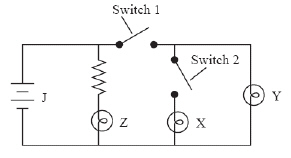 a. Identify the symbol
labeled J in the circuit. b. Describe what each light bulb does in each of the following
situations:
• when switches 1 and 2 are
open
• when switches 1 and 2 are
closed
• when switch 1 is open and switch 2 is
closed
• when switch 1 is closed and switch 2 is
open
|
|
|
28.
|
In an experiment, the current is varied as it goes through the resistor in a
circuit. An ammeter measures the current going through the resistor and a voltmeter measures the
voltage across the resistor. The data are recorded and shown below. (MCAS
2007)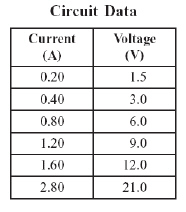 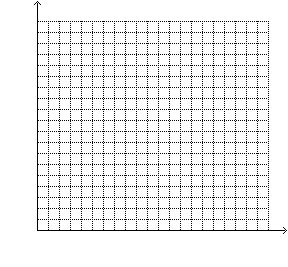
a. Using the data in
the table, make a graph of the voltage versus the current in the circuit. Voltage should be on the
y-axis. Make sure the graph has clearly labeled axes and a proper scale.
b.
Find the slope of the graphed line. Show your calculations and include
units in your answer.
c. Explain what the slope
represents.
|
|
|
29.
|
A student performs an experiment to determine the relationships among voltage,
current, and resistance. The student’s procedure includes the following steps: (MCAS 2013)• Connect a 3.0 V battery to a 42 W resistor. • Measure the current using an ammeter and record the
value. • Replace the 42 W resistor with a 54 W resistor, and then with a 66 W resistor, measuring
and recording the current for each resistor. The table below shows the data
collected. a. Draw a schematic
diagram of the student’s original circuit with the 42 W resistor. Be
sure to label the battery and the resistor.
b. Describe in
words the relationship between current and resistance as voltage is held constant.
The
student will investigate these relationships further using a different experiment.
c.
Write a procedure the student could use to test the relationships
among voltage,current, and resistance if the only materials available for use are three 3.0 V
batteries,one 30 W resistor, wire, and an ammeter.
d.
Make a data table similar to the Student’s Data table above to
show the expected current measurements for your procedure from part (c). Show your calculations and
include units in your answer.
|
|
|
30.
|
An electrician places a variable resistor in series with an LED lamp and a 6 V
battery, as shown below. (Modified MCAS 2011)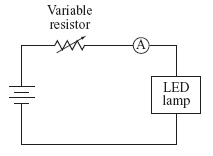 |
LED lamps
are efficient sources of light that operate at a specified voltage for a wide range of currents. The
LED lamp in this circuit operates at a constant 3 V for all settings of the variable resistor, while
the remaining 3 V is always dropped across the variable resistor. | | | | | |
a. Calculate the current passing through the
variable resistor when it is set to each of the values shown in the table below. Show your
calculations and include units in your answers. 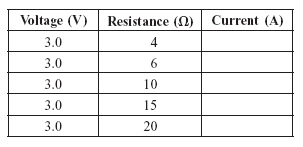 b.
On the grid below, make a graph using your answers to part (a).
Current should be on the y-axis and resistance should be on the x-axis. Clearly label
the axes and use a proper scale. 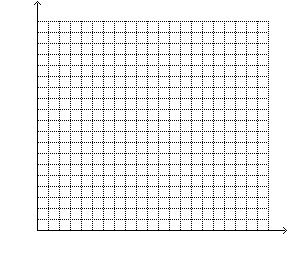 |
c. Based on the graph,
describe what happens to the LED lamp as the resistance decreases.
| | |
The maximum recommended current for the LED lamp is 0.3 A.
d.
If the LED lamp is operated for a long time with the variable resistor
set at 4W, describe the most likely effect on the LED
lamp.
|